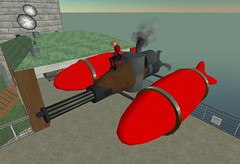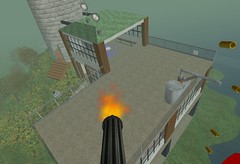I have been informed several times in the last week that my Touring Dirigible in Caledon has been found in peculiar places. Some of these places are understandable - say, trapped in a tower which has grown somewhat since I last plotted the course - but some are frankly inexplicable. For instance: even given the vagaries of the physics engine, how could a dirigible find its way
inside the top floor of the Academy, when it is actually too large to enter?
I suspect that some
person has been taking pot-shots at my balloon. This is not a pastime that meets with my approval. I have therefore put into place further scripting which will enable me to locate any such culprit should this occur again (as well as raising the travelling height of the balloon somewhat).
Further on the subject of balloons, various of the landed gentry of Caledon seem to have become recently most interested in the practice of diplomacy, manifesting itself in the construction of gunboats. Whilst I am at heart a peaceful soul and wish no part in imperialist endeavours, I clearly cannot let such a craze go past without contributing in some small way, lest my reputation as a gunsmith suffer.


Hence the Ordinal Gun Balloon, built around a giant cannon somewhat reminiscent of my Engine Rifle, though much larger. A most diplomatic device, I'm sure you will agree, though pedestrians should be aware that it is, well, almost impossible to actually
hit anything smaller than a wildebeest, except perhaps by accident.
To be honest the building was largely inspired by my desire to build a vehicle that utilised Mouselook for its guidance. Whilst not in Mouselook, one controls the Gun Balloon fairly conventionally, rotating it, moving forwards and backwards and the like. Whilst in Mouselook, however, the balloon orientates itself to point in the direction that you are looking.
This is not a terribly complicated effect to achieve at heart, merely requiring the use of
llSetVehicleFlags(VEHICLE_MOUSELOOK_STEER);. However, I was somewhat perplexed for a while as to how, precisely, to get this to work. The mistake that I was unknowingly making involved the
angular motor. The Wiki is fairly clear on this, but I had, ahem, not actually read that section.
For the direct information of those reading though, the issue is that the value of the angular motor whilst VEHICLE_MOUSELOOK_STEER is active is
not actually the value of the angular motor, as such. Instead, the angular motor is controlled entirely by the direction that the avatar is looking in and its difference from the vehicle's current forward X-axis - and the value of the angular motor is in fact a
scaling factor for this. So, if one uses:
llSetVehicleVectorParam(VEHICLE_ANGULAR_MOTOR_DIRECTION, <1.0, 1.0, 5.0>);whilst Mouselook Steering is active, rotation about the vehicle's Z-axis will be five times more responsive than about other axes. Being the silly sausage that I am I was regularly setting the angular motor to zero, thus cancelling all of my piloting mouselookery completely.
~ * ~
The vital issue of
suitable hats, though, has not been satisfactorily addressed in Caledon to my mind. One cannot have naval vessels, aerial or otherwise, without appropriate headgear, and, to be frank, epaulets are needed as well. Hats first, diplomacy later.
~ * ~
I am aware that I seem to be spending less and less time here writing on the subject of the actual mechanics of scripting. I am not precisely sure why that is, but to be frank, I suspect that it is because I am now past the stage where I am constantly encountering new functions within LSL of which I was not previously aware, and am now more at the stage where one wrangles with reality itself, using the functions as a tool with which hopefully to beat the laws of physics into submitting to one's will. Quite frequently, of course, the capricious spirits governing the natural sciences within Second Life merely laugh at the feeble attempts of mere mortals to achieve their goals, and there is little that one can do against their will.
I was wondering whether one could take a different approach to trying to beat them with Science, and instead try to appease them.
Praying to
their masters is sometimes effective but again, a slow process. I thought, for instance, that one might have a vehicle which, upon approaching the famously haunted borders between Sims, began a ritual chant and perhaps lit some incense. I am not quite sure what sacrifices the Spirits Of The Physics Engine really appreciate - they certainly seem to enjoy taking my balloons, so perhaps a set of smaller balloons could be launched to meet their approval.
I have found, on this subject, that when a dirigible is crossing these boundaries, if it slows down to a walking pace and begins to repeat a mantra, it is much less liable to being thrown into the centre of the Grid or otherwise discombobulated. (One cannot actually
hear the mantra, but trust me, it is repeating it within its little scripted mind.)
~ * ~
I must mention finally the most appropriate movement by certain of those with Power in Second Life to remove the detritus that silts up the Events listings, sometimes involving
the presence of a green and purple pony. I am not one to criticise
potted meat, a fine invention, but really - it is appropriate for sailors, explorers, students,
not lists of Events, where one should be able to find unique occurrences rather than simply folk playing baccarat or whatever it is people do all day in casinos.







